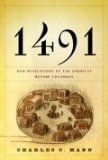Summary | Excerpt | Reading Guide | Reviews | Beyond the Book | Readalikes | Genres & Themes | Author Bio

Critics' Opinion:
Readers' Opinion:
First Published:
Aug 2005, 480 pages
Paperback:
Oct 2006, 528 pages
 Book Reviewed by:
Book Reviewed by:
BookBrowse Review Team
Buy This Book
A friendly Indian named Squanto helped the colonists. He showed them how
to plant corn and how to live on the edge of the wilderness. A soldier,
Captain Miles Standish, taught the Pilgrims how to defend themselves
against unfriendly Indians.
My teacher explained that maize was unfamiliar to the Pilgrims and that
Tisquantum had demonstrated the proper maize-planting technique—sticking
the seed in little heaps of dirt, accompanied by beans and squash that
would later twine themselves up the tall stalks. And he told the
Pilgrims to fertilize the soil by burying fish alongside the maize
seeds, a traditional native technique for producing a bountiful harvest.
Following this advice, my teacher said, the colonists grew so much maize
that it became the centerpiece of the first Thanksgiving. In our
slipshod fashion, we students took notes.
The story in America: Its People and Values isn't wrong, so far as it
goes. But the impression it gives is entirely misleading.
Tisquantum was critical to the colony's survival, contemporary scholars
agree. He moved to Plymouth after the meeting and spent the rest of his
life there. Just as my teacher said, Tisquantum told the colonists to
bury several small fish in each maize hill, a procedure followed by
European settlers for the next two centuries. Squanto's teachings,
Winslow concluded, led to "a good increase of Indian corn"—the
difference between success and starvation.
Winslow didn't know that fish fertilizer may not have been an age-old
Indian custom, but a recent invention—if it was an Indian practice at
all. So little evidence has emerged of Indians fertilizing with fish
that some archaeologists believe that Tisquantum actually picked up the
idea from European farmers. The notion is not as ridiculous as it may
seem. Tisquantum had learned English because British sailors had
kidnapped him seven years before. To return to the Americas, he in
effect had to escape twice—once from Spain, where his captors initially
sold him into slavery, and once from England, to which he was smuggled
from Spain, and where he served as a kind of living conversation piece
at a rich man's house. In his travels, Tisquantum stayed in places where
Europeans used fish as fertilizer, a practice on the Continent since
medieval times.
Skipping over the complex course of Tisquantum's life is understandable
in a textbook with limited space. But the omission is symptomatic of the
complete failure to consider Indian motives, or even that Indians might
have motives. The alliance Massasoit negotiated with Plymouth was
successful from the Wampanoag perspective, for it helped to hold off the
Narragansett. But it was a disaster from the point of view of New
England Indian society as a whole, for the alliance ensured the survival
of Plymouth colony, which spearheaded the great wave of British
immigration to New England. All of this was absent not only from my high
school textbooks, but from the academic accounts they were based on.
This variant of Holmberg's Mistake dates back to the Pilgrims
themselves, who ascribed the lack of effective native resistance to the
will of God. "Divine providence," the colonist Daniel Gookin wrote,
favored "the quiet and peaceable settlement of the English." Later
writers tended to attribute European success not to European deities but
to European technology. In a contest where only one side had rifles and
cannons, historians said, the other side's motives were irrelevant. By
the end of the nineteenth century, the Indians of the Northeast were
thought of as rapidly fading background details in the saga of the rise
of the United States—"marginal people who were losers in the end," as
James Axtell of the College of William and Mary dryly put it in an
interview. Vietnam War–era denunciations of the Pilgrims as imperialist
or racist simply replicated the error in a new form. Whether the cause
was the Pilgrim God, Pilgrim guns, or Pilgrim greed, native losses were
foreordained; Indians could not have stopped colonization, in this view,
and they hardly tried.
Excerpted from 1491 by Charles C. Mann Copyright © 2005 by Charles C. Mann. Excerpted by permission of Knopf, a division of Random House, Inc. All rights reserved. No part of this excerpt may be reproduced or reprinted without permission in writing from the publisher.





The House on Biscayne Bay
by Chanel Cleeton
As death stalks a gothic mansion in Miami, the lives of two women intertwine as the past and present collide.

The Flower Sisters
by Michelle Collins Anderson
From the new Fannie Flagg of the Ozarks, a richly-woven story of family, forgiveness, and reinvention.

The Funeral Cryer by Wenyan Lu
Debut novelist Wenyan Lu brings us this witty yet profound story about one woman's midlife reawakening in contemporary rural China.
Your guide toexceptional books
BookBrowse seeks out and recommends the best in contemporary fiction and nonfiction—books that not only engage and entertain but also deepen our understanding of ourselves and the world around us.